In This Report:
Other Links
Contact Us:

Pesticides
Background
A pesticide is any substance used to kill or control the growth and development of insects, plants, fungi, bacteria, rodents, or other unwanted organisms. New Jersey is home to a diverse landscape of agricultural fields, golf courses, housing developments, and other features that rely on pesticide use to maintain healthy and productive communities. Pesticides help to increase food production and quality, and reduce insect-borne disease, but their use can also pose adverse impacts on the environment. Once released into the environment, pesticides can move to streams and ground water where they may impact wildlife and contaminate drinking water resources. Pesticides have the potential to affect nearly every New Jersey resident, and this creates a need for balance between the risks and benefits of pesticide use.
Pesticides can be divided into two broad groups based on their production: chemical and biological (biopesticides). Historically, chemical pesticides are typically man-made materials that directly kill or inactivate the pest. Some insecticides, known as organophosphates and carbamates, generally work by affecting the nervous system through disruption of acetylcholinesterase, an enzyme that regulates the neurotransmitter acetylcholine. Another class of insecticides known as neonicotinoids works differently by binding to insect nicotinic acetylcholine receptors in the central nervous system, which disrupts nerve transmissions and ultimately leads to insect death.1 Neonicotinoids bind more strongly to insect receptors, making them more toxic to insects than mammals.2 Herbicides kill plants by impairing metabolic and developmental processes unique to plant life. Likewise, fungicides impair the metabolic processes of fungi. Biopesticides are derived from naturally occurring materials and include microbial, plant incorporated protectants (PIPs) and biochemical classes.
Pesticides are regulated at the federal level by the US Environmental Protection Agency (EPA) and at the state level by the New Jersey Department of Environmental Protection (DEP). EPA classifies pesticides as either general use or restricted use.3,4 General use pesticides may be used by anyone, while restricted use pesticides may only be used by a licensed applicator or under the direct supervision of a licensed applicator. Certain pesticides are classified for restricted use because without added restrictions, they have the potential to cause unreasonable adverse effects to the environment or injury to applicators or bystanders.
DEP must be at least as strict as EPA with its pesticide classifications, but in some instances has chosen to restrict additional pesticides in New Jersey5 that are otherwise classified as general use at the federal level. For example, EPA has classified certain neonicotinoid insecticides for restricted use while other neonicotinoids remain available for general use. In order to be more protective of pollinators, New Jersey has chosen to restrict all neonicotinoid insecticides by passing legislation in January 2022 (P.L.2021, c.386). Specifically, this law serves to ban the use of neonicotinoid pesticides for all outdoor purposes other than agricultural applications, with some limited exceptions. These restrictions will be effective October 31, 2023.
Integrated Pest Management (IPM)
DEP initiatives are implemented to ensure that those who choose to apply pesticides do so in a safe and proper manner, thereby minimizing pesticide exposure to the public and the environment.6 A cornerstone of these efforts is Integrated Pest Management (IPM), which is a comprehensive approach to controlling pests that employs methods discouraging or preventing pest invasion through improved sanitation, engineering modifications, and other techniques before resorting to chemical applications. IPM promotes effective pest management while limiting the potential exposure and risk associated with traditional pesticide application. In 2004, regulations were adopted requiring the implementation of IPM practices at public, private and charter schools throughout the state.7 These measures reduce children’s exposure to potentially harmful pesticides and help safeguard public health. These regulations are important because children are more vulnerable and susceptible than adults to the toxic effects of pesticides.8,9
Status and Trends
The New Jersey Pesticide Control Program began a series of pesticide use surveys in 1985. These surveys are conducted on a rotating three-year schedule and provide the starting point for both assessing the risk and determining the impact of pesticide use. The surveys are administered to categories of licensed applicators in New Jersey including those involved in agriculture, golf course maintenance, lawn care, mosquito control, right-of-way, and structural pest control (structural data are not included in this trend report due to differences in scale and type of application). Usage data from these sectors are collected and used by programs within the DEP, along with other state agencies to aid in research, exposure management and monitoring effects in areas such as ground water protection, farm worker protection and education, and residual pesticide sampling. These data are specific for New Jersey and can identify both the type and area of potential exposures to New Jersey residents. One limitation of this data set is that it does not include pesticides used by the general population.
In previous iterations of this report, some pesticides were identified as high risk (HR) based on their potential risks to human and environmental health due to the compounds’ acute and/or chronic toxicity, or likelihood of entering ground or surface waters. In this report update, pesticides are instead identified by classification and are grouped as general use or restricted use, consistent with federal and state regulations.
The following figures summarize pesticide use data collected for the various sectors surveyed for the period 1999 to 2019. Agricultural pesticide application represents the largest proportion of pesticide use in the state, followed by lawn care and golf course applications (Figure 1). While there are some fluctuations of amounts used from period to period, overall totals in each usage category have remained consistent over time except for lawn care, where there has been a statistically significant increase in total usage from 1999 to 2019 (Kendall’s tau = 0.90, p < 0.05). When total pesticide application is split into restricted use pesticides and general use pesticides for all sectors combined, there is no statistical trend (Figure 2). However, when comparing total pesticide usage to the 1999-2001 period, there were increases of 25% for the 2014-2016 period and 14% for the 2017-2019 period.
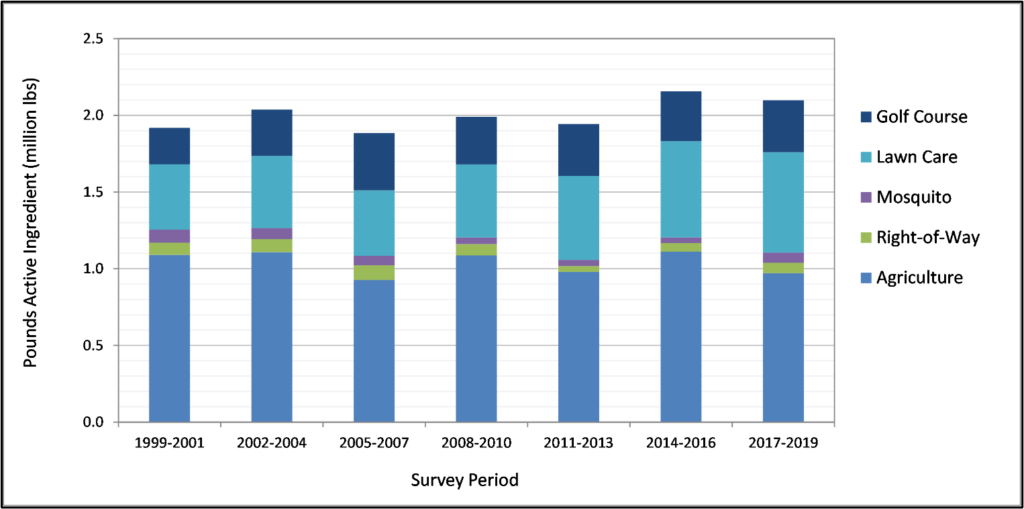
Figure 1. Total statewide pesticide application by survey.
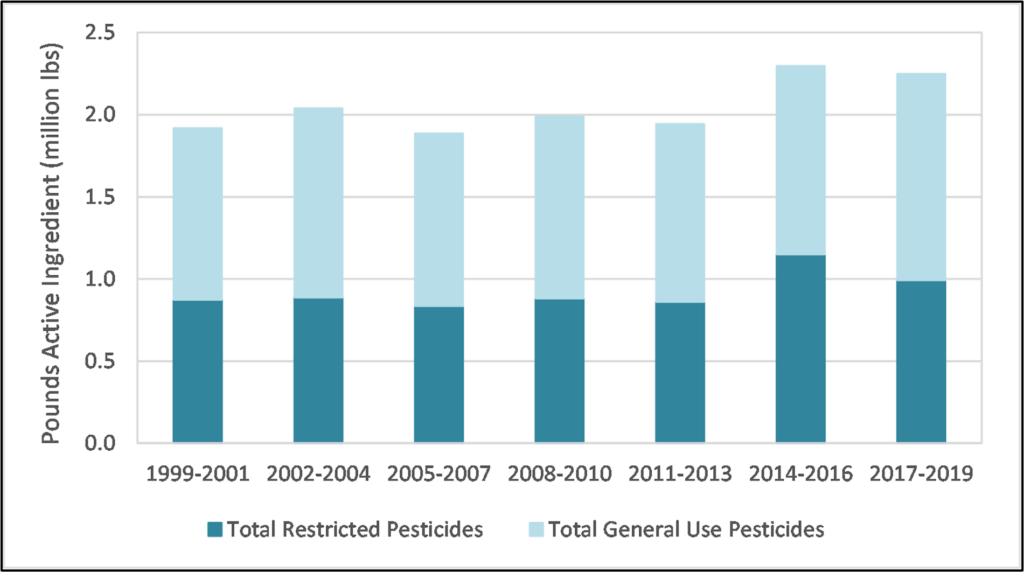
Figure 2. Total statewide pesticide application by usage classification (restricted and general use).
Figure 3 presents restricted pesticide usage by pesticide type. Since 1999, there has been a statistically significant increase in the use of restricted herbicides (Kendall’s tau = 0.81, p < 0.05) and restricted fungicides (Kendall’s tau = 1, p < 0.05). There is no statistical trend in the usage of restricted insecticides.
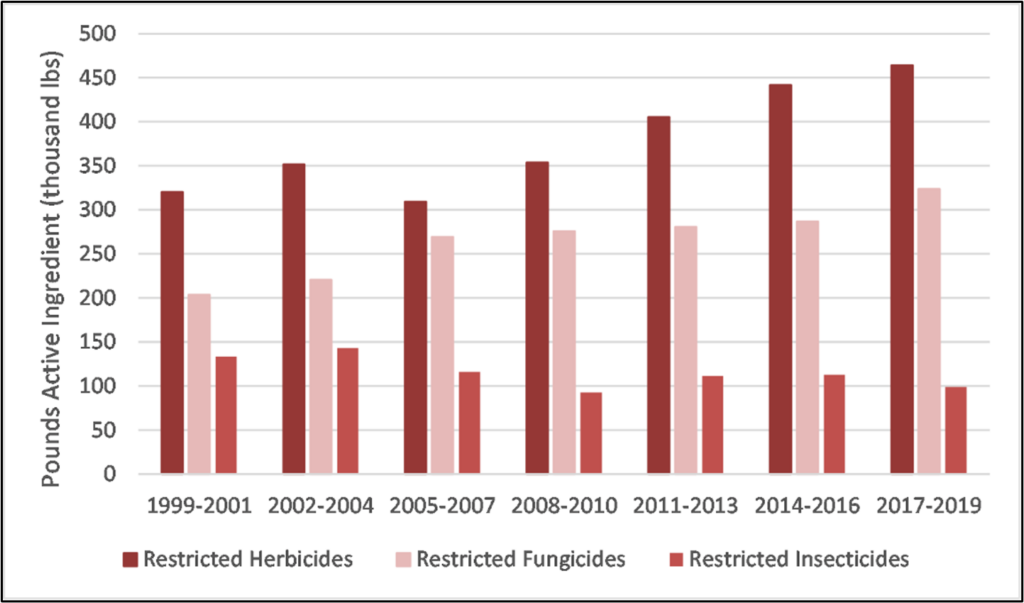
Figure 3. Total restricted use pesticide applications are displayed by type (Herbicide, Insecticide, and Fungicide).
Agricultural use surveys were conducted every third year since 1985. Before 2000, total agricultural pesticide use as measured by pounds of active ingredient (AI) applied, was fairly consistent between 1.1 and 1.4 million pounds AI per year (Figure 4). After 2000, agricultural use dropped, hovering around 1 million pounds AI and the percentage of restricted pesticides used for agriculture dropped from 39% to 27% of the total amount of AI applications recorded. Through 2000, the total agricultural application of restricted pesticides was between 45,000 to 53,000 pounds AI. After 2000, the range of agricultural restricted application has been 28,000 to 46,000 pounds AI.
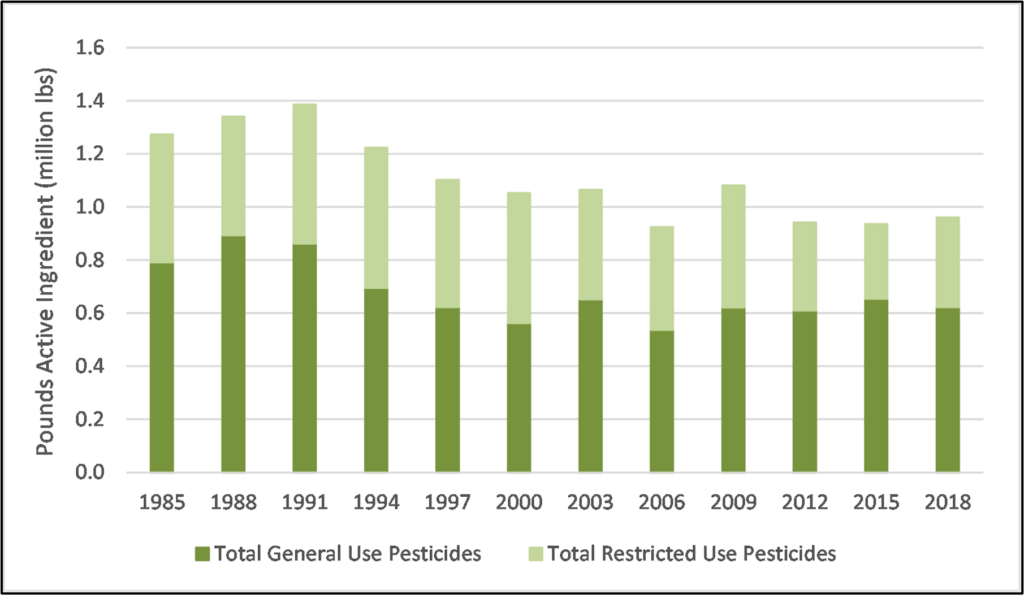
Figure 4. Total agricultural general use and restricted use pesticide application reported since 1985.
Also focused on agricultural pesticide usage, Figure 5 shows a decrease in the amount of restricted herbicide and insecticide application since the beginning of the survey period while restricted fungicide usage has remained fairly constant as a percentage of total AI application over time. Most notable is the drop in restricted herbicide applications as a percent of total AI application from 1997 to 2000. This decrease is largely due to reductions in the usage of Metolachlor (116,167 lbs. AI in 1997 to 54,411 lbs. AI in 2000), Chlorthal-dimethyl (18,475 lbs. AI in 1997 to 676 lbs. AI in 2000), Atrazine (30,143 lbs. AI in 1997 to 12,585 lbs. AI in 2000), Alachlor (46,171 lbs. AI in 1997 to 29,137 lbs. AI in 2000) and Cyanazine (20,551 lbs. AI in 1997 to 5,750 in 2000). These reductions coincide with increasing applications of an unrestricted pesticide, Glyphosate, that began when genetically modified organism (GMO) soybeans were introduced in the late 1990s.
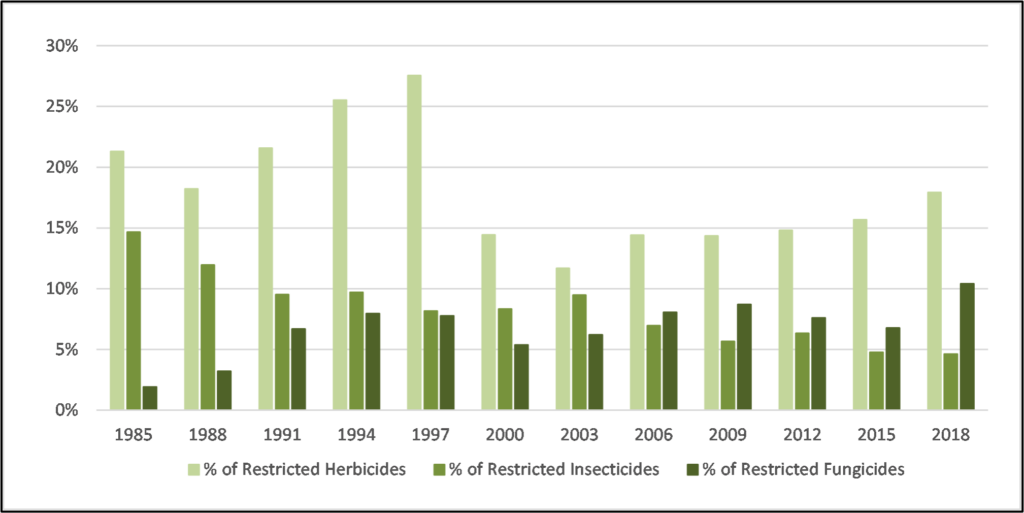
Figure 5. The percent of restricted use agricultural pesticides by class described as a percent of the total pesticides applied for agricultural use.
Outlook and Implications
In reporting and evaluating pesticide use, it is important to consider the many diverse influences on pesticide use. Weather conditions influence pest pressure and the associated response, as does cropping patterns in agricultural settings. The changing climatic variables of increasing temperature and increasing precipitation from extreme events may impact pesticide use. Pesticide degradation is expected to accelerate in warmer temperature, decreasing effectiveness.10 This will combine with reduced persistence due to more intense rainfall events, a longer growing season for some crops, and changing pest populations needing to be addressed.11 Growing populations of invasive species, such as Spotted Lanternfly, will continue to drive pesticide use. Economic factors, such as the changing demands for seasonal crops and recreational activities can also play a significant role in pesticide use. Finally, the changing land use patterns around the State where many new residential developments are constructed on past agricultural lands also plays a part in shifting pesticide use patterns.
More Information
NJ Department of Environmental Protection, Pesticide Control Program, https://www.nj.gov/dep/enforcement/pcp/bpo.htm
References
1Simon-Delso, N., Amaral-Rogers, V., Belzunces, L.P., Bonmatin, J.M., Chagnon, M., Downs, C., Furlan, L., Gibbons, D.W., Giorio, C., Girolami, V., Goulson, D., Kreutzweiser, D.P., Krupke, C.H., Liess, M., Long, E., McField, M., Mineau, P., Mitchell, E.A., Morrissey, C.A., Noome, D.A., Pisa, L., Settele, J., Stark, J.D., Tapparo, A., Van Dyck, H., Van Praagh, J., Van der Sluijs, J.P., Whitehorn, P.R., & Wiemers, M. (2014). Systemic insecticides (neonicotinoids and fipronil): trends, uses, mode of action and metabolites. Environ Sci Pollut Res Int. 2015 Jan;22(1):5-34. Doi: 10.1007/s11356-014-3470-y. PMID: 25233913; PMCID: PMC4284386.
2Ihara, M., & Matsuda, K. (2018). Neonicotinoids: molecular mechanisms of action, insights into resistance and impact on pollinators. Curr Opin Insect Sci. 30:86-92. doi: 10.1016/j.cois.2018.09.009. Epub 2018 Sep 27. PMID: 30553491.
3US EPA Restricted Use Products (RUP) Report, https://www.epa.gov/pesticide-worker-safety/restricted-use-products-rup-report, Accessed 10/20/2021.
4US EPA 40 CFR 152.60-152.175
5N.J.A.C. 7:30-2.10
6NJ A.C. 7:30-13. Accessed 9/27/2016. http://www.state.nj.us/dep/enforcement/pcp/pcp-regs.htm
7Environmental Protection Agency. Fact Sheet: Pesticides and their impact on children. Accessed 1/10/17. https://www.epa.gov/sites/production/files/2015-12/documents/pest-impact-hsstaff.pdf
8National Research Council. (1993). “Pesticides in the Diets of Infants and Children”.
9Pascale, A., & Laborde, A. (2020). Impact of pesticide exposure in childhood. Reviews on environmental health, 35(3), 221-227. Accessed 1/19/2023. https://www.degruyter.com/document/doi/10.1515/reveh-2020-0011/html
10Matzrafi, M. (2019). Climate change exacerbates pest damage through reduced pesticide efficacy. Pest. Manag. Sci., 75(1), 9–13, doi:10.1002/ps.5121.
11Delcour, I., Spanoghe, P., & Uyttendaele, M. (2015). Literature Review: Impact of climate change on pesticide use. Food Research International, Volume 68, Pages 7-15.